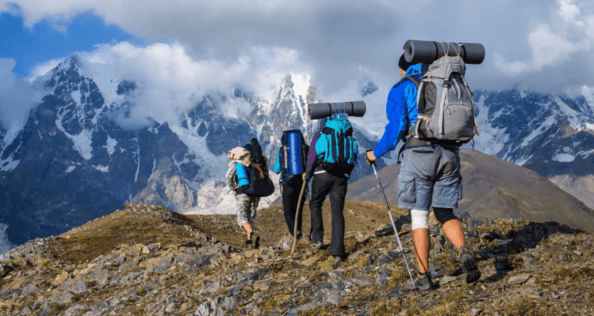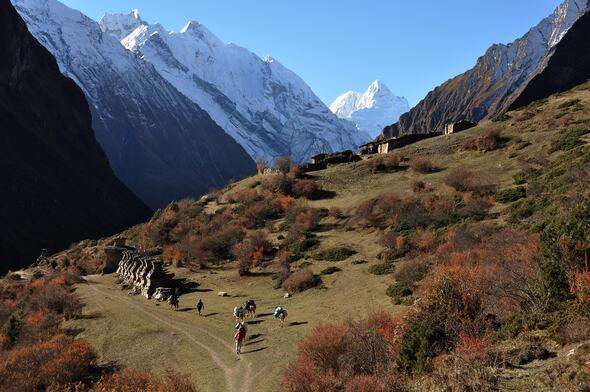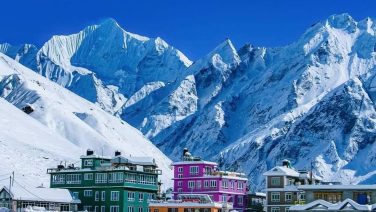TL;DR:
- Pack season-appropriate gear; waterproof for rainy seasons, warm clothing for dry months.
- Essential items: boots, warm sleeping bag, map, hat, gloves, first-aid kit, water purifiers, and snacks.
- For high altitudes, include oxygen, quality sunglasses, sun hat, and strong sunscreen.
- Ghorepani Poon Hill, Kathmandu Valley treks, and Annapurna Base Camp suitable for first-timers.
- Best trekking times: pre-monsoon (Mar-May) for clear skies, flowers; avoid winters at high altitudes due to snow.
- Monsoon (Jun-Sep) offers lush landscapes but require waterproof gear and flexible plans.
- Altitude sickness: Be aware of symptoms; prevent with acclimatization, hydration, and consulting a doctor prior to trekking.
- Budget-friendly treks possible with careful planning; daily spend ~$20-$30 on popular routes.
- Permit fees and additional costs, such as travel, gear, and food, must be accounted for in the budget.
- Local guides enhance safety and provide cultural insights; Sherpa guides offer invaluable high-altitude expertise.
- Practice sustainable trekking by minimizing waste, respecting cultural norms, and supporting local communities.
Get ready for a trek that will touch your soul! Heading to the soaring peaks of Nepal? Wonderful! But before you step into this adventurer’s paradise, you need to pack right. I’ve roamed these trails, and I can tell you, smart packing makes all the difference. Stick around as I help you craft the perfect checklist for hiking in Nepal. You’ll learn the essentials to bundle up for your Himalayan journey, whether you’re seeking serene beginner hikes or the thrill of high altitudes. Let’s dig in and make sure your trekking gear in Nepal is spot on!
Table of Contents
What Essentials Should I Pack for Trekking in Nepal?
How Do I Choose the Right Gear for Different Trekking Seasons?
When you plan a trek in Nepal, think about the season. In dry months, you need light, warm gear for the cool nights. In the rainy season, waterproof items are a must. Check gear lists before you go.
What Are the Must-Have Items in My Trekking Backpack?
You can’t trek without some key items. A sturdy pair of boots, a warm sleeping bag, and a good map are tops. Add a hat and gloves for cold, and always bring a first-aid kit. Don’t forget water purifiers and snacks, too.
You’ll want layers for when it gets hot or cold. Pack a few moisture-wicking shirts and pants with zip-off legs. Trust me, dressing right can make or break your hike. Also, pack a durable jacket that can stand wind and rain. For a full checklist, many trekkers look to the gear list provided by trekking experts like Exotic Mountains.
Are There Specific Recommendations for High Altitude Trek Gear?
Yes, for high treks, like Everest or Annapurna, oxygen and proper glasses are key. Solar rays hit harder up there. Bring a good sun hat and strong sunscreen. A solid wind jacket will help, too. Remember, at high altitudes the weather changes fast.
To wrap up, Nepal’s trails will leave a mark in your heart. The peaks reach the clouds, and the locals’ smiles are pure joy. You’ll need to be ready for anything. Pack smart, and your trek will be as enjoyable as the majestic views.

Which Are the Top Treks for First-Timers in Nepal?
Why Opt for the Ghorepani Poon Hill Trek as Your First?
Let’s dive into the Ghorepani Poon Hill trek. It’s a go-to pick for anyone new to hiking in Nepal. This easy trek takes about 4-5 days, making it a best short trekking place in Nepal for those tight on time. It’s gentle on your legs and treats your eyes with sunrise views on Poon Hill. From up there, you can catch the Annapurna and Dhaulagiri ranges all lit up by the morning sun. You don’t need much gear, just stamina and maybe a taste for Nepali tea.
In the hike, you’ll travel through colorful forests and charming villages, great for meeting locals. Ghorepani Poon Hill is perfect for capturing Nepal’s beauty without the long days on other routes. And yes, you can hike here almost all year, except when it’s really wet or snowing hard.
Can The Kathmandu Valley Offer Fulfilling Treks for Beginners?
The Kathmandu Valley, surprisingly, holds some great starter hikes. These trails lie just a step away from the city’s hustle. They’re easy treks in Nepal that take you from temples to lookout points.
Try the Nagarkot trek for clear views of the Himalayas. You can walk through tiny towns, learn about local life, and relax amidst nature. Want a mix of culture and nature? Check out the Chisapani trek that includes both. This trek won’t wear you out and still offers those grand views Nepal treks are famous for.
What Makes the Annapurna Base Camp Trek Ideal for New Trekkers?
Annapurna Base Camp, or ABC, is more of a challenge but it’s totally doable for new trekkers with a decent fitness level. Over 10 days, you’ll get up close with Annapurna I, trekking through diverse landscapes. From forested paths to high ridge lines, each day brings something new.
It’s a moderate trek and you’ll need to step up your game a bit. There’s a steady climb, but you’re rewarded with some of the most stunning mountain scenes. ABC is also one of the best short trekking places in Nepal, as you can get a true taste of the Himalayas in less than two weeks. Like Poon Hill, the best times to hit this trail are spring and autumn when skies are clearest.
When Is the Best Time to Go Trekking in Nepal?
What Are the Advantages of Trekking During the Pre-Monsoon Season?
The pre-monsoon season, from March to May, is a prime time for hiking in Nepal. Skies clear up, and days are warm. Flowers bloom across the hills, painting the landscape in vibrant colors. This time is ideal for photographers and nature lovers alike, offering clear views of the majestic Himalayas. The temperature is comfortable, making the trek pleasant, and the longer daylight hours give you more time to enjoy the trails and soak in the breathtaking surroundings.
Is Winter Trekking in Nepal Suitable for All Trekkers?
Winter trekking, from December to February, can be a bold move. Some trails are snowed in, and temperatures drop significantly. This season typically sees fewer hikers, which means you can enjoy the trails at a slower pace. However, it’s important to note that not all treks are ideal during winter. Higher elevation treks may be too cold and risky due to snow. If you plan to hike during this season, make sure your chosen trail is safe and accessible. Sturdy boots, warm clothes, and proper gear are must-haves.
How Does the Monsoon Impact Trekking Routes in Nepal?
The monsoon season hits Nepal from June to September. It brings heavy rains that can make trails slippery and unsafe. Landslides and leeches are also common during this time. Despite this, some trekkers still venture out, as the rains transform the countryside into a lush, green paradise. Yet, it’s crucial to be well-prepared for the challenges. Sturdy, waterproof gear and flexibility with your trekking plans are key. Always check with local guides before heading out to ensure that your chosen route is open and safe.
Remember, the best time for hiking in Nepal also depends on the trek you pick. Every trail has its own perfect season. For example, the trekking seasons in Nepal for the Annapurna Circuit and the Annapurna Base Camp are autumn and spring, when the weather is mild, and the views are clear.
Planning your hike according to the right season will enhance your experience immensely. Not only will you get to enjoy the natural beauty at its peak, but you’ll also be safer, and more prepared for what each trail has in store. Remember to check local sources or visit trusted online guides like Exotic Mountains to get the most accurate, up-to-date information to plan your trip. Safe travels and happy trekking!
What Should I Know About Altitude Sickness While Hiking in Nepal?
How Can I Recognize the Symptoms of Altitude Sickness?
Altitude sickness hits when you climb too high, too fast. Your body yells, “Hey, slow down!” How? You might feel dizzy, get headaches, or throw up. It’s like your body runs out of power. You must rest or go down to feel better.
When hiking high in Nepal, watch for these signs. They tell you to stop and take care. If you ignore them, altitude sickness can get bad. It can even become life-threatening.
Are There Preventative Measures for Altitude Sickness on Nepalese Treks?
Yes, you can dodge altitude sickness on your Nepal hike. Climb slow and let your body get used to the height. This means plan your trek so you only go up a small bit each day. Also, sleep lower than the highest point you reach. Before your trip, get fit and talk to a doctor. While hiking, drink lots of water and eat healthy foods.
Some hikers use pills to help, but chat with a pro before you try pills. They can tell you if it’s a good idea. Also, know your way or have a guide. They can spot sickness early and help.
What Are the Treatment Options if I Experience Altitude Sickness?
If sickness hits, the best fix is to drop down to a lower height. Do this fast. Rest and drink water. If you feel very sick, you might need a doctor or even a rescue. In towns, you can find clinics that know how to treat hikers. Keep in mind, if you feel bad at high heights, don’t wait. Go down right away.
In Nepal, the mountains are high and the air is thin. This means your hikes will be great, but you might face altitude sickness. Know the signs and how to prevent it. Have a plan if you get sick. This keeps you safe while you explore the beautiful peaks and paths.
How Much Should I Budget for a Trek in Nepal?
Can I Enjoy a Quality Trekking Experience on a Budget in Nepal?
Yes, you can have a great trek in Nepal without spending much. Nepal offers a range of hiking experiences fitting various budgets. Cost of hiking trips in Nepal varies based on the route, season, and your spending habits. If you plan carefully and choose budget treks in Nepal, you can save money and still take in the stunning views and culture.
Start with a Nepal trekking package price in mind. Many local companies offer affordable packages that include the basics. These can range anywhere from $300 to $1500 and sometimes higher, depending on the trek’s duration and services. Remember, local guides add value with their expertise and help in supporting the local economy.
When you pick a trek, think about the Annapurna Circuit or Basecamp. These are popular for their beauty and villages where you can stay and eat at a low cost. If you’re careful with your money, expect to spend about $20-$30 per day on these treks.
How Do Permit Fees Influence the Overall Cost of Trekking in Nepal?
Permit fees are a small but necessary cost. You’ll need a TIMS card and permits for the areas you’ll explore. For example, the Annapurna Conservation Area Permit will set you back about $20. These fees help maintain the trails and support conservation efforts. Don’t let these costs surprise you. Plan for them as you budget.
What Additional Costs Should I Account for When Planning a Trek?
There are other costs you shouldn’t overlook. First, think about travel to and from your starting point. Internal flights, buses, and taxis can add up. Next, consider your food along the trail. While tea houses offer meals, prices can increase with altitude. Gear is another cost, including proper boots and clothing. Don’t forget a sleeping bag and backpack.
Also, think about water treatment options. Bottled water is costly and bad for the environment, so invest in a good water purifier or treatment tablets. Lastly, save some money for emergencies or unplanned expenses. It’s always smart to have a little extra.
To sum up, you can trek in Nepal without breaking the bank. You need to plan wisely and consider all costs. Do your research and use local trekking packages to help set your budget. With some careful planning, you can enjoy the beauty and culture of Nepal without spending too much.

How Do Trekking Guides Enhance My Hiking Experience in Nepal?
Why Should I Consider a Local Guide for My Himalayan Trek?
Local guides make your trek safe and fun. They know the paths and can help if you get sick. Guides tell stories about the area, adding meaning to your walk. They show you secret spots you might miss alone.
What Unique Insights and Benefits Do Sherpa Guides Offer?
Sherpa guides bring their culture to life on your trek. They teach local customs, help you talk with villagers, and explain the Himalayan ecosystem. Their skills in high-altitude hiking keep you safe.
How to Select the Best Trekking Agency for Your Nepal Adventure?
Look for agencies with good reviews and local guides who speak English well. Check they care for their team, offer fair prices, and focus on safety. A top-notch service offers a memorable hike without worries. Choose a trekking partner from the best trekking agency in Kathmandu.
What Are the Sustainable Trekking Practices in Nepal?
How Can I Minimize My Environmental Impact While Trekking?
When you trek in Nepal, think of nature as your host. To thank it, leave no trace. Carry reusable water bottles to avoid plastic waste. Stick to marked trails to protect the land. Take all trash back with you or dispose of it properly. Your steps towards eco-friendly trekking in Nepal make a big difference!
What Role Does Cultural Sensitivity Play in Sustainable Trekking?
Trekking here is not just about nature. It’s about the people, too. Dress modestly. Learn a few local words. Always ask before taking photos. By being kind and showing respect, you care for the culture. This is a part of responsible trekking in Nepal. Cultural sensitivity keeps traditions alive and communities happy.
How Are Local Communities Benefiting From Sustainable Trekking Practices?
Your trek can help the people you meet on the path. Choose local guides and stay in village teahouses. Buy handmade gifts. Eat meals made with local produce. By doing this, you support jobs and keep culture strong. Sustainability on Nepali trails means locals benefit, too. You give back to those who make your trek special.
Trekking in Nepal is a step into nature’s heart. Let’s make that step a gentle one. Practice these ways to care for the land and its people. And check out Exotic Mountains for more on traveling right. Your journey through Nepal can leave a lasting good mark. Let’s make each trail better than we found it!
When Is the Best Time to Go Trekking in Nepal?
Say you want to start hiking in Nepal. When should you go? The best times are from late September to early December, and from late February to April. These months give you clear weather and safe trails.
Now let’s dive into each season so you know what to expect.
What Are the Advantages of Trekking During the Pre-Monsoon Season?
Pre-monsoon time is between March to May. It is a great time for hiking. You get warm weather, longer days, and the rhododendrons are in full bloom. The skies may be hazy, but the hills glow with color.
Is Winter Trekking in Nepal Suitable for All Trekkers?
No, winter trekking is not for everyone. Winter is from December to February. Trails can be cold and snowy. Some high passes may close. It’s good for low altitude walks though.
How Does the Monsoon Impact Trekking Routes in Nepal?
Monsoon season runs from June to early September. It rains a lot, which can cause landslides. Paths can be slippery and leeches come out. Still, it’s less crowded and the countryside is a lush green. Fewer people hike in monsoon days, so it’s quiet.
When planning your hike, watch the weather. Each trail may be different. Some places like Upper Mustang, are dry even in monsoon season. Consider your comfort and safety when picking a time.
No matter when you visit, Nepal’s mountains will amaze you. The right season makes your trek safer and more fun. So choose well, and Nepal’s trails will treat you to a trip of a lifetime.
Conclusion
In this guide, we’ve covered what to pack for Nepal’s trekking adventures. We gave tips on gear for different seasons, must-have backpack items, and high-altitude gear advice. We explored beginner treks and the best times to hike in Nepal. We discussed dealing with altitude sickness, budgeting for your trip, the perks of having a guide, and ways to trek sustainably. Trek smart, embrace the culture, and enjoy Nepal’s stunning trails safely!




